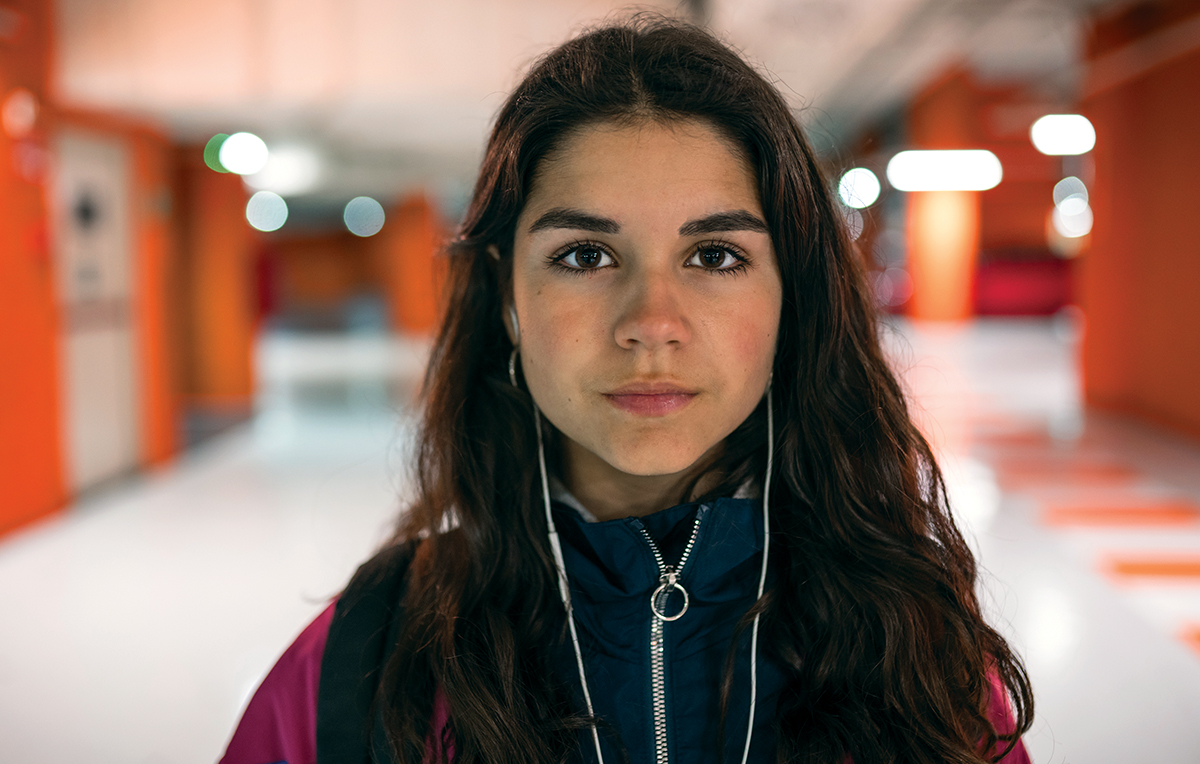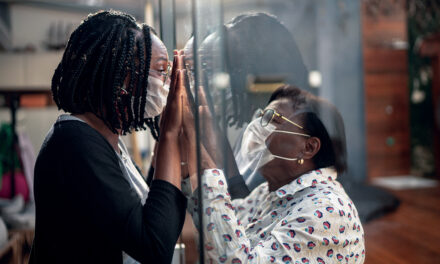The COVID-19 pandemic is wreaking havoc on our lives, but the impact on teenage girls is one of the most profound and concerning byproducts. Real Woman investigated to find out how to help them.
In December of 2019, Brittany Girard* was living the life of the lead in the best high school movie ever. She was popular. She got straight As. She probably didn’t get enough sleep, but no one knew about that, so it was fine.
Then the pandemic took it all away in a matter of weeks when New Jersey went into lockdown. Brittany’s parents were strict about following safety guidelines, so the only person who left her house for months was her dad, who did the grocery shopping. “But I could see on Instagram that everyone else was still going out. It was all over their feed—like, pictures of huge groups of people,” she says. “I said no to so many things that people stopped asking. I was missing out on everything.” She started sleeping through her Zoom classes and her grades began to suffer, which was a wake-up call she couldn’t ignore. “I actually asked my parents to find me a therapist. I didn’t know what I was going to even say on the first call,” says Brittany. “But after I started talking, the words just came rushing out.”
After a few sessions, topics she had been ignoring for years started bubbling up, and she and her therapist worked on them week by week. As it turns out, there were a lot of them. She now sees this as a turning point not only in her view of the pandemic but of her “old” life—and the agency she has over herself moving forward. “Some of my friends were posting racist or homophobic comments online, and I cut them off,” she says. “Same with people I figured out don’t have my back. That wasn’t what I started going to therapy for, but it’s something that changed how I think about who I let into my life.
“I used to feel anxious and alone,” she adds. “Now I’m anxious but excited about things getting back to normal, and I know what to do if I need help.”
But so many teen girls are in the thick of crisis, leaving many of us to question how we got here and how we can support them. We reached out to parents, therapists, and experts to give us a meaningful place to start.

Social Media Dangers (and Benefits)
According to former Facebook product manager Frances Haugen, Facebook’s own internal research found that 13.5 percent of teen girls said Instagram worsens suicidal thoughts and 17 percent of teen girls say the platform contributes to their eating disorders. Mental health experts describe social media as a “free-for-all,” where cyberbullying, sexting, and other dangerous behaviors are being “normalized.” And it’s not improving: The Cyberbullying Research Center reported a 40 percent increase in cyberbullying between early 2020 and the middle of 2021. In terms or subgroups, who identify as LGBTQ, female, or white or multiracial are more likely to be bullied than those who are in binary, male, or other racial groups.
However, not all research slams social media. In the 2021 report “Coping with COVID-19: How Young People Use Digital Media to Manage Their Mental Health,” authors noted that social media played a dual role during the pandemic. Yes, it spreads misinformation and hate speech, but it also connected teens to life-saving mental health resources, social-action movements, and long-distance friends. The report suggests a shift in focus from “young people as a monolithic group to individuals who have unique risks and varying degrees of vulnerability.” Groups like Common Sense Media are pressuring tech companies and Congress to make the digital landscape safer. Until then, we can educate ourselves with online materials from trusted sources like cyberbullying.org, while monitoring them (in person) for signs of mental health distress or the spread of misinformation.
We were concerned about children’s emotional and behavioral health even before the pandemic. The ongoing public health emergency has made a bad situation worse.
AACAP President, Gabrielle A. Carlson, MD
Help on the Way
On October 19, 2021, three groups declared a national state of emergency in child and adolescent health: the American Academy of Pediatrics, the American Academy of Child and Adolescent Psychiatry, and the Children’s Hospital Association (whose membership includes Capital Health hospitals). “We were concerned about children’s emotional and behavioral health even before the pandemic. The ongoing public health emergency has made a bad situation worse,” says AACAP President, Gabrielle A. Carlson, MD. In addition to having their schedules and social support system interrupted, many teens have faced COVID-related illnesses and deaths of loved ones, experienced family financial instability and job loss, and seen a rise in racism and xenophobia. The groups are encouraging policymakers to increase federal funding for mental health services, improving access to telehealth and in-person counseling, supporting mental health services in schools, integrating mental health into pediatric practices, and working harder to reduce suicides in children and teens.
While it’s encouraging that hospitals, professional organizations, schools, and pediatricians are stepping up to support the mental health of today’s teens, there is much that parents can do at home to help their girls (and themselves) navigate the shifting sands of this pandemic. Below are six tips you can try, starting today.
But first, give yourself some grace. “There’s been no prep for this,” said Julie Lythcott-Haimes, author of How to Raise an Adult: Break Free of the Overparenting Trap and Prepare Your Kid for Success, in an interview with The New York Times. “We’ve had to flail while simultaneously performing the part of a parent who kids can rely on for emotional support.” It may be helpful to remind yourself that you’re doing the best you can with the information you have right now.

Help for You
Here are a few of the most click-worthy resources to help you help them.
Article: “Coming of Age: Teens on a Year That Changed Everything.” This article shares responses from a survey by the New York Times of more than 5,500 teenagers regarding their experiences during the pandemic. In one excerpt, Aishah Musa, a 16-year-old from Elizabeth, NJ, shares a text message exchange with her sister in which she asks how to put on a mask when wearing a hijab. Her advice: Put on the mask before the hijab—something that still wasn’t second nature for Aishah nearly a year later.
Resource: Mental Health and Wellness Resources for Young Adults. This new “web tool” was introduced by New Jersey Governor Phil Murphy to connect parents with resources to address young people’s mental health challenges, which have been
exacerbated by the pandemic. It also includes guidance on signs and symptoms that indicate your child may need professional mental health
support. Access it by visiting the New Jersey COVID-19 web page or directly via covid-19.nj.gov/youthhelp.
Courses: The Capital Health Child and Adolescent Behavioral Health Program was launched in January 2021 to address the challenges facing today’s youth. In December, Tatyana Gray, a licensed master social worker with the program, led an online meeting called Managing Mood: Teen DBT Skills. DBT stands for Dialectical Behavior Therapy, which involves mindfulness and regulation of emotions, managing painful situations, and learning to communicate better. Check capitalhealth.org/classes-events.
1. Broach difficult subjects.
Many parents worry that talking about topics like suicide and self-harm will lead teens to carry out plans. That’s simply not true, say mental health experts. If you have reason to be concerned, including a gut instinct, ask your child if she is having thoughts of suicide. If she is, seek professional help immediately. Capital Health’s mental health hotline can be reached 24/7 at 609-396-HELP (4357).
Also, have conversations with your teen girls about what’s happening in the news, including hard topics like racism and gender identity. “If you see something on the news or social media, it’s really important to assume that your teen has seen it as well,” said Isha Metzger, PhD, an assistant professor of clinical psychology at the University of Georgia in an article titled, “Communicating With Teens During COVID.”
2. Be a better listener.
Teenagers may not know why they feel the way they feel. Or they may be so busy getting from one assignment, activity, or class to the next that they don’t stop to think about their emotional well-being. You can start by validating and empathizing with them, then asking a big-picture question. For example, “At this time last year, you were learning remotely, which was hard. Now that you’re back in the classroom, I was wondering: What’s that been like for you?”
Also, try to understand what “asking for a friend” means. Pay special attention when your daughter starts telling you about a challenge that a friend at school is facing, as she may be sharing her own concern or experience about struggling with schoolwork, being bullied, or being hyper-focused on food intake.
Avoid comparing your teen’s experience to something that happened to you, downplaying their feelings or the seriousness of the situation, or sharing your opinions or unsolicited advice on the topic. Don’t think of conversations as “teachable” moments, think of them as “learnable” moments for yourself.
3. Help them curate the feed.
Laura Tierney, the founder and chief executive of The Social Institute, recommends talking to teens about their social media accounts. A good conversation starter: Ask them to share their top five accounts, and share your own picks on your feed, then discuss why each of you feels that way. “You want to be around accounts that help you become the best version of yourself,” Tierney told the New York Times.
4. Encourage being “other-oriented” in a good way.
Worrying about what someone just called you on Instagram becomes less impactful when you just spent a few hours serving meals to people facing food insecurity. A recent study in Frontiers in Psychology suggested that teen volunteerism might help promote “positive spirals” in mental health at a time of life when their brains are especially sensitive to social influences.
5. Reset the boundaries of your relationship.
Research has linked parental anxiety with overparenting—which can be defined as doing things for kids that they could easily developmentally do for themselves—and it’s more common in moms than in dads. These past 2 years may have triggered some moms to do more for their teens than they did before, either out of necessity or safety. The antidote to overparenting, say experts, is to recognize your own value and life as an independent person—a friend, an athlete, a hobbyist, a career woman, and more—and to start prioritizing your needs and interests.
6. Normalize mental health.
While social media has normalized some inappropriate and harmful things, it has also opened up discussions about mental health and the importance of making it a priority. (Thank you, Simone Biles and Naomi Osaka, who have shared their personal struggles.) It’s also important for parents to embrace not only the idea of therapy or counseling but to seek it ourselves when we need it—and to let all our kids know (age appropriately) when and why we do.
“My mom wished she could have fixed everything or helped me instead of my therapist,” says Brittany. “But it was the best thing to be able to talk to someone who wouldn’t judge you at all. One of the best things my therapist did was help me take a step back. Now, when I get that weird feeling like you get just before you’re ready to cry, I tell myself, None of this is forever. None of this is about me. Someday this is going to just be a story I tell.”





